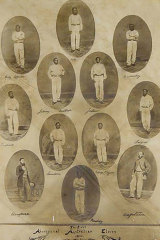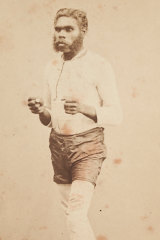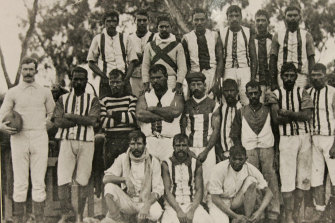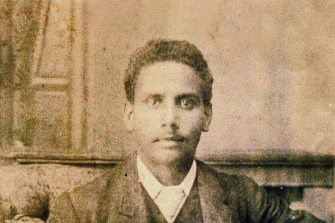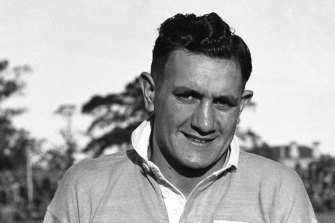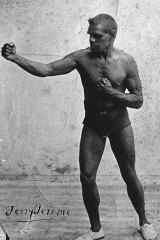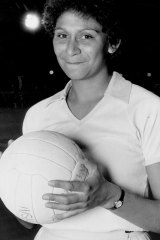Before Artie Beetson, Michael Long and Cathy Freeman, these true trailblazers played and won
Artie Beetson, Michael Long, Cathy Freeman, the Ella brothers – Australia’s greatest Indigenous athletes are all household names whose backstories of sacrifice and success, toil and triumph have been told and retold countless times over the years.
But what about the true trailblazers; the pioneers who played or competed before or just after federation, in the darkness of Australia’s colonial era, and paved the way for the stars who would follow them in the many decades to come? Back then, sport was one of the only ways for Indigenous men (rarely women – we’ll get to that later) to engage on relatively level terms with a white society which had invaded their land and marginalised them. In the face of often horrific adversity, they played and won.
To all but a small circle of sports history buffs and academics, their names have been long forgotten, the details of their lives lost to the sands of time so a truly definitive or exhaustive list is impossible to compile.
In celebration of NAIDOC week, the Herald and The Age has dusted off the history books and jumped head-first into the archives to celebrate the earliest athletes who broke through the race barrier.
Aboriginal and Torres Strait Islander readers are advised this story contains the names and images of people who have died.
1868 Indigenous cricket team
The first Australian cricket team to tour Britain was an all-Aboriginal team in 1868.
The first Australian cricketers to tour England were all Aboriginal men. A decade before the first “official” Australian representative team would leave the country, these 13 stockmen from cattle stations in Victoria’s west played a gruelling 47 two-day matches during their six-month journey against a variety of English amateur teams. Led by captain-coach Charles Lawrence, an Englishman brought out as the first professional coach in NSW, the star was Johnny Mullagh, who scored 1698 runs at an average of around 20 on what were said to be difficult pitches, and bowled 1877 overs, including 831 maidens, and took 245 wickets, averaging 10 runs. He also donned the wicket keeper’s gloves at times to make four stumpings – a true all-rounder. One of his teammates, known as “King Cole”, died from tuberculosis during the trip. ”Their hair and beards are long and wiry, their skins vary in shades of blackness, and most of them have broadly expanded nostrils,” wrote The Times. “Having been brought up in the bush to agricultural pursuits under European settlers, they are perfectly civilised and are quite familiar with the English language.“ A law brought in shortly after their return to Australia banned any Aboriginal person from leaving Victoria without government consent, effectively stopping Indigenous players from further high-level involvement in cricket.
Jackie Lynch, aka ‘Quilp’
Believed to be the first Indigenous man involved in soccer, little is known about “Quilp”, who was spotted in the middle of a photo of the 1910 Dinmore Bush Rats team by historian Ian Syson several years ago when he was trawling through digital newspaper archives. Listed only by that mysterious mononym, further research revealed his real name was Jackie Lynch, and that he had been competing with and against white men in and around Ipswich, Queensland, from as early as 1904. He was also a referee of some repute, played competitive quoits in 1908, boxed as a featherweight in 1909, and spent some time as a buffalo hunter in the Northern Territory. How he was able to enter such sporting circles during a time of great change for Aborigines in Queensland may never be known, but he was later forcibly moved by police to the Barambah Aboriginal Settlement. Along with the slightly more prominent “Bondi” Neal, Quilp represents the “only substantial uncovered evidence” of Indigenous involvement in soccer before the 1950s, according to Syson. Both cases suggest there could well have been others like them over the years whose stories have slipped through the cracks of history.
Charles Samuels
Before the first Summer Olympics had even been run and won, there was a Kamilaroi man who was captivating crowds in Australia with his speed and building a reputation as one of the world’s fastest men. Born in southern Queensland to parents from northern NSW, Charles Samuels worked as a stockhand on Jimbour station but had a natural talent for running that would see him compete in professional circuits across south-east Queensland and Sydney. In 1888, he set an Australian record when he ran 134 yards in 12.5 seconds in Botany. Standing at 170 cm tall, the Referee sporting newspaper once described him as a specimen built to run, with “tremendous hips and thighs, and a long tapering calf”, an agreeable personality and a “beautiful action” which was the “secret of his pace”. The same newspaper also begrudgingly (because of his race) acknowledged him as the best sprinter in Australia and “one of the best exponents of sprint running the world has ever seen”.
Albert ‘Pompey’ Austin
Albert “Pompey” Austin played Australian Rules in its early years and was a talented runner, cricketer, hurdler, high-jumper, boxer, singer, musician and orator.
Born Poorne Yarriworri but better known by his nickname “Pompey”, Albert Austin was the first and only Indigenous man to play top-level Aussie Rules football in Victoria during the 19th century – a time when First Nations involvement was almost nonexistent, in stark contrast to today’s AFL. Austin played a single match for Geelong in the Victorian Football League, against Carlton on May 25, 1872. Neither side scored a goal and Austin had little influence, and was probably selected primarily for his athletic ability rather than his skill, given the rugged nature of the game back then bore little resemblance to modern footy, and was seen as a bit of a novelty addition to Geelong’s team. He was also a talented runner, cricketer, hurdler, high-jumper, boxer, singer, musician and orator. “What’s not to love about someone like that, who is a black man in a world which treats him and his colleagues with total contempt?” historian Roy Hay, the author of Albert ‘Pompey’ Austin: A man between two worlds, told the ABC.
Cummeragunja Aboriginal Football Club
The AFL’s Indigenous round is named after Sir Doug Nicholls, but few know the remarkable story of the all-conquering Aboriginal team that came from the mission where he was born, on the banks of the Murray River in NSW, and showed white Australia how to really play the game. The Cummeragunja Aboriginal Football Club often had difficulty getting permission to leave the mission to play, but they went through the 1898 and 1899 seasons undefeated in the Nathalia District Football Association thanks to a thrilling, speedy, handball-heavy style of game that prompted some people to revisit their prejudices. “The Australian ‘natives’ … can certainly claim to be possessed of as much intelligence as any race under the sun. It was a sight to make the proud Britisher feel humble, or at any rate to shake his confidence in the superiority of the race,” wrote the Bendigo Independent after one match involving the “Invincibles” as they became known. Between 1926 and 1931, Cummeragunja won five premierships in six years until a competition ban was brought in on men over the age of 25, seemingly targeting their best players. It was widely seen as punishment for being too good.
The Cummeragunga Football Club often had difficulty getting permission to leave the mission to play,Credit:Fairfax
Frank Ivory
The first Indigenous man to play rugby union for Queensland, Frank Ivory was born to a wealthy Scottish father who was a grazier and politician (and who helped introduce the game of golf to Australia), and a mother from the Gurong Gurong and Wakka Wakka tribes in the South Burnett. Ivory went to school in Maryborough, 250km north of Brisbane, and while his father’s reputation probably opened doors that were otherwise shut for young Indigenous boys, he quickly became renown for his sporting prowess in the 1880s.
Frank Ivory was inducted into the Queensland Rugby Union hall of fame.
First, he played Aussie Rules, which was the dominant code in Queensland, and represented his state in 1889 and 1890. When clubs in the area agreed to switch to rugby union, Ivory continued to stand out, earning Queensland selection in 1893. Various reports said he was a household name, a humble hero with a “great turn of speed and football brain” and “splendid physique” who was clearly the best footballer in the area. He was later inducted into the Queensland Rugby Union hall of fame and has a medal named after him, given by the Reds to the best player during Indigenous round.
Cecil Ramalli
One of the great forgotten Australian sporting stories. Not only was Cecil Ramalli, born in 1919, the first Indigenous Wallaby, he was the first Asian Wallaby too – and was also a survivor of the nuclear bomb dropped on Nagasaki. His father was an Indian Muslim trader, his mother a local Indigenous woman from the NSW-Queensland border town of Mungindi.
Cecil Ramalli was a Wallaby and a Japanese prisoner of war.Credit:SMH
Their success in business enabled them to send the diminutive Ramalli to school in Sydney, where he became a crafty halfback and made the first XV of the Hurlstone Agricultural High School aged just 15. Thus began his rapid ascent through the representative ranks, which saw him earn his international debut just four years later against New Zealand, starring despite suffering a broken nose. The Courier Mail said: “Ramalli made such a splendid debut, he should become one of the greatest players the game has produced.” But when he was in England with the Wallabies the following year, ready for another taste of Test rugby, the Second World War broke out. Ramalli enlisted. On August 9, 1945, having been captured by the Japanese, he was working as slave labour in the coal mines of Nagasaki and was underground when the Americans dropped the bomb.
Jerry Jerome
Jerry Jerome helped pave the way for the likes of Lionel Rose, Dave Sands and Anthony Mundine.
The “Warra Cyclone”, as Jerry Jerome was known, helped pave the way for the likes of Lionel Rose, Dave Sands and Anthony Mundine to become Indigenous boxing icons. Born at the Jambour homestead in Queensland’s Darling Downs in 1874, Jerome took up boxing at the age of 34, and was lauded for his quick hands and ability to dance and weave through trouble – and, according to some reports, an “ungovernable temper”. Four years into his career, in 1912, he beat Charlie Godfrey to claim the national middleweight title and become Australia’s first Indigenous boxing champion. Earlier that year he also beat Western Australian champion Black Paddy in what is thought to be Australia’s first all-Indigenous bout. He retired with a record of 35 wins and 23 losses from 58 fights, and spent the years before his death coaching young Indigenous boxers. Despite earning decent sums of money throughout his time in the ring, “Jerry Jerome ended life as he began it, in squalor, and stone motherless broke,” according to the Truth newspaper.
‘Bondi’ Neal
Long before John Moriarty and Charlie Perkins broke through the ranks of Australian soccer, Walter Ernest “Bondi” Neal was the world game’s first Indigenous star in this country. So much of his life remains a mystery – including his family, where he was from, and how he died – but we do know he was an accomplished, versatile athlete who also played senior cricket, rugby union and rugby league in Kurri, and boxed for good measure. And we do know he earned a big reputation for his acrobatic feats and safe, reliable presence as a goalkeeper while playing for about a decade from 1904 for various teams in the coalfields of the Hunter Valley, including Pelaw Main, Kurri Kurri and Weston. He then moved to back to his native NSW South Coast, but that is where information about him drops away. “His disappearance from the records and from memory remains mysterious,” writes Professor John Maynard in The Aboriginal Soccer Tribe. “It is possible that he died or never reached the South Coast after he left Newcastle. In any case, we are left to recognise his wonderful but all-too-short career as a remarkable goalkeeper.” His nickname, “Bondi”, was a corruption of “Bunda” (kangaroo), a nickname he was supposedly given as a child due to his athleticism.
Marcia Ella-Duncan
Marcia Ella-Duncan said her Aboriginality made her invisible.Credit:The Age
Finding women for this list has not been easy, given the lowly status of women’s sport so many years ago and the little coverage it received in newspapers at the time. But Marcia Ella-Duncan, who in 1986 became the first of only two Indigenous netballers to represent Australia, stands out as a key figure. The ninth from a family of 12 children who grew up in La Perouse – among them brothers Mark, Glen and Gary, who all played for the Wallabies – Ella-Duncan was also the first Indigenous woman to hold a scholarship at the AIS, and was inducted into the Netball Australia hall of fame in 2015. Only one other player, Shannon Finnan-White (1990), has followed in her footsteps since. “Coaches and selectors, they might say I was a late bloomer,” Ella-Duncan said on Nine’s Super Netball Indigenous round coverage two years ago. “I’d say my Aboriginality made me invisible. I had a wonderful career. But as I look back now the stats don’t lie. There simply aren’t enough of us playing at this elite level. That’s because there has not been enough effort or support to understanding Indigenous athletes.”
News, results and expert analysis from the weekend of sport sent every Monday. Sign up for our Sport newsletter.
Most Viewed in Sport
From our partners
Source: Read Full Article
